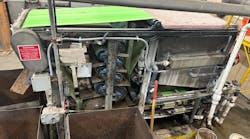The meat industry (poultry included) generates some 30 billion pounds of inedible surplus each year. The rendering industry contributes tremendously to efforts to maintain a clean and healthful environment and prevent a waste disposal problem by turning this otherwise unusable material into usable commodities.
One challenge renderers face in creating a clean environment is the treatment of their wastewater. The type and degree of wastewater treatment required depends on whether the plant discharges its effluent to a city sewer, a navigable stream or a lagoon.
The first step in treating rendering wastewater is primary treatment, which removes suspended solids, oil and grease and reduces BOD and COD. The HydroCal CAF system is a highly effective pretreatment system in reducing the concentration of these pollutants in the wastewater. The CAF will in turn reduce discharge fees as well as recover fats and protein solids that can be recycled into new products.
The CAF system has been successful at numerous rendering facilities, and one rendering company has installed these systems in 78 percent of its plants so far.
Table 1: CAF System Performance
Influent Effluent Reduction
TSS 25,000 230 99.1%
FOG 15,000 215 98.6%
BOD 29,000 4,500 84.5%
COD 66,000 13,600 79.4%
Download: Here

